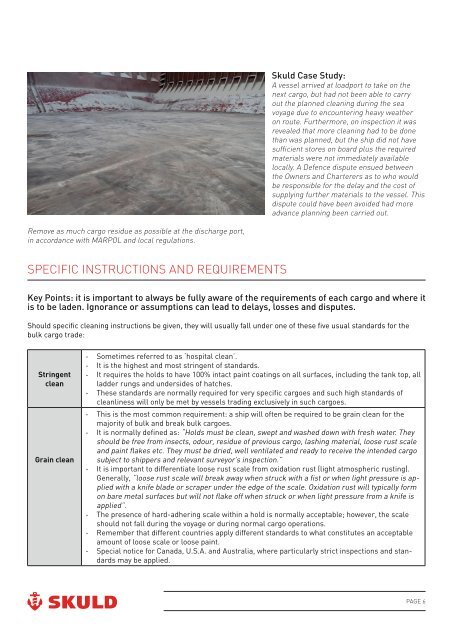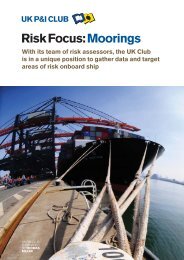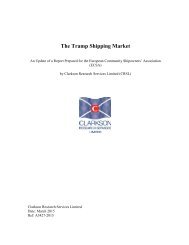Preparing cargo holds_ Loading solid bulk cargoes
Preparing cargo holds_ Loading solid bulk cargoes
Preparing cargo holds_ Loading solid bulk cargoes
You also want an ePaper? Increase the reach of your titles
YUMPU automatically turns print PDFs into web optimized ePapers that Google loves.
Skuld Case Study:<br />
A vessel arrived at loadport to take on the<br />
next <strong>cargo</strong>, but had not been able to carry<br />
out the planned cleaning during the sea<br />
voyage due to encountering heavy weather<br />
on route. Furthermore, on inspection it was<br />
revealed that more cleaning had to be done<br />
than was planned, but the ship did not have<br />
sufficient stores on board plus the required<br />
materials were not immediately available<br />
locally. A Defence dispute ensued between<br />
the Owners and Charterers as to who would<br />
be responsible for the delay and the cost of<br />
supplying further materials to the vessel. This<br />
dispute could have been avoided had more<br />
advance planning been carried out.<br />
Remove as much <strong>cargo</strong> residue as possible at the discharge port,<br />
in accordance with MARPOL and local regulations.<br />
SPECIFIC INSTRUCTIONS AND REQUIREMENTS<br />
Key Points: it is important to always be fully aware of the requirements of each <strong>cargo</strong> and where it<br />
is to be laden. Ignorance or assumptions can lead to delays, losses and disputes.<br />
Should specific cleaning instructions be given, they will usually fall under one of these five usual standards for the<br />
<strong>bulk</strong> <strong>cargo</strong> trade:<br />
Stringent<br />
clean<br />
Grain clean<br />
- Sometimes referred to as ‘hospital clean’.<br />
- It is the highest and most stringent of standards.<br />
- It requires the <strong>holds</strong> to have 100% intact paint coatings on all surfaces, including the tank top, all<br />
ladder rungs and undersides of hatches.<br />
- These standards are normally required for very specific <strong>cargo</strong>es and such high standards of<br />
cleanliness will only be met by vessels trading exclusively in such <strong>cargo</strong>es.<br />
- This is the most common requirement: a ship will often be required to be grain clean for the<br />
majority of <strong>bulk</strong> and break <strong>bulk</strong> <strong>cargo</strong>es.<br />
- It is normally defined as: “Holds must be clean, swept and washed down with fresh water. They<br />
should be free from insects, odour, residue of previous <strong>cargo</strong>, lashing material, loose rust scale<br />
and paint flakes etc. They must be dried, well ventilated and ready to receive the intended <strong>cargo</strong><br />
subject to shippers and relevant surveyor’s inspection.”<br />
- It is important to differentiate loose rust scale from oxidation rust (light atmospheric rusting).<br />
Generally, “loose rust scale will break away when struck with a fist or when light pressure is applied<br />
with a knife blade or scraper under the edge of the scale. Oxidation rust will typically form<br />
on bare metal surfaces but will not flake off when struck or when light pressure from a knife is<br />
applied”.<br />
- The presence of hard-adhering scale within a hold is normally acceptable; however, the scale<br />
should not fall during the voyage or during normal <strong>cargo</strong> operations.<br />
- Remember that different countries apply different standards to what constitutes an acceptable<br />
amount of loose scale or loose paint.<br />
- Special notice for Canada, U.S.A. and Australia, where particularly strict inspections and standards<br />
may be applied.<br />
PAGE 6




